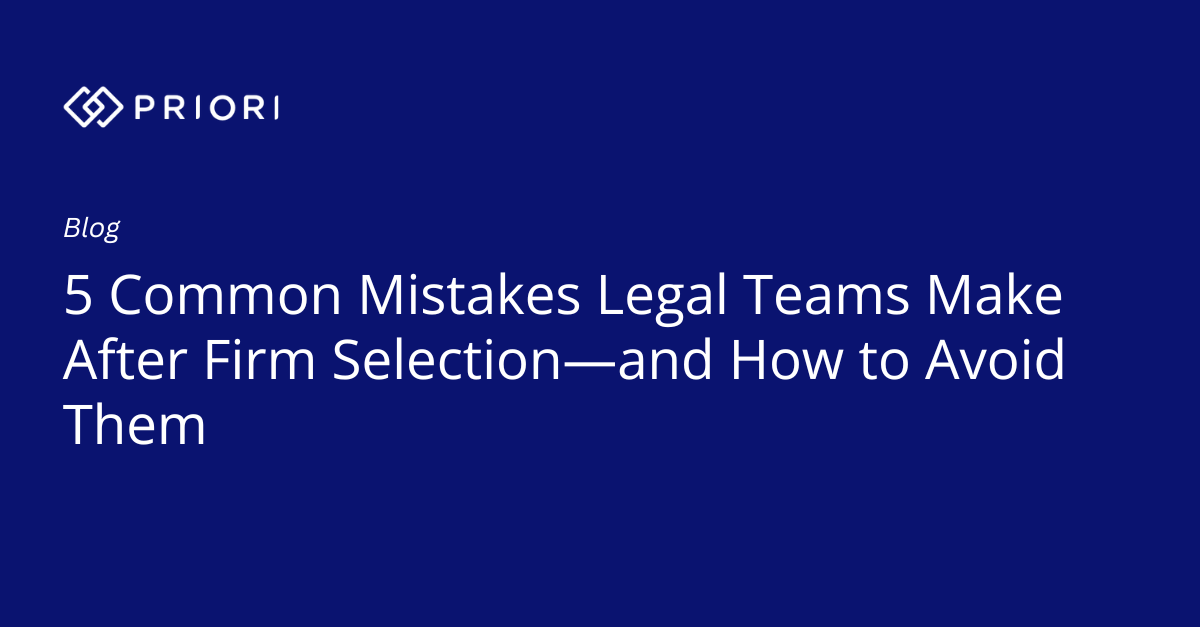Choosing a law firm is a high-stakes decision, but it’s only one step in the matter lifecycle. What happens after the engagement can have just as much impact on cost control, firm relationships, and overall legal department performance.
Too often, legal teams do the hard work to select a firm, and then lose visibility and momentum the moment work begins.
Here’s how it typically plays out:
A team runs a thoughtful RFP. They compare proposals, weigh experience and pricing, and select the best fit for the matter. Everyone agrees on a budget. The kickoff email is sent, and then the tracking stops.
The matter progresses, but updates are shared ad hoc. Invoices trickle in. There’s no easy way to compare actual spend to the original quote, no system for checking if the scope has shifted, and no documentation of why a firm was chosen in the first place.
By the time finance asks for a quarterly report, the team is scrambling to piece together spreadsheets, email threads, and outdated accruals.
These challenges are common across legal departments, especially those managing complex matters without integrated post-selection processes.
Here are five common mistakes legal teams make after selecting a firm, along with practical tips to avoid them.
1. Tracking Spend in Excel (Or Not at All)
Many legal teams still track spend the old-fashioned way—manually, using spreadsheets that get updated quarterly, or sometimes only at year-end. By the time actuals are reviewed against the original budget, the matter is already well underway or completed. There’s no opportunity to course-correct, and no clarity into whether agreed-upon budgets were followed.
How to avoid it: Implement a process for reviewing budget vs. actuals in real time. Priori’s flexible eBilling integrations make this possible by linking any billing system directly to RFPs, giving attorneys live visibility into spend throughout the matter—not just after it’s too late to act.
2. No Real-Time Budget Visibility
Without a system to flag when spend is approaching the budget threshold, surprises are inevitable. Legal teams might only find out a matter went over budget during quarterly business reviews or finance audits which can be long after overages have occurred.
How to avoid it: Set automated alerts and visual dashboards that notify matter owners and legal ops when spend nears or exceeds agreed-upon limits. Real-time visibility empowers attorneys to step in, renegotiate scope, or address issues proactively.
3. Panel Firms Get Overlooked
Legal departments invest heavily in building panel programs, but they’re not always used effectively. Without guardrails and visibility, attorneys may continue to engage legacy firms or personal contacts, even when panel firms have pre-negotiated rates, favorable terms, and better alignment with corporate policies.
How to avoid it: Centralize access to approved firms. A searchable hub that highlights panel firms, past matter history, performance trends and comparative data makes it easy for attorneys to engage the right firms quickly.
4. RFPs Get Buried (and Forgotten)
Once a firm is selected, the rationale behind that decision is often lost. Was it the best rate? The most relevant expertise? The best client reviews? Without documentation, it’s difficult to understand what worked and what didn’t, and nearly impossible to improve the process next time.
How to avoid it: Capture and store the selection rationale with the matter record. This supports audits, informs future decisions, and promotes organizational learning that strengthens firm selection over time.
5. Attorneys Are Disconnected from Cost Management
In many organizations, attorneys are focused on legal strategy and day-to-day matter management, while budgeting and financial oversight are owned entirely by legal ops. This disconnect creates a lack of accountability that can lead to overages, duplicative work, and misaligned expectations.
How to avoid it: Provide attorneys visibility into their budgets and make cost management part of their workflow. With better tools and timely data, attorneys can engage outside counsel in more informed conversations about scope, spend, and efficiency.
Selecting the right firm is just the beginning. To drive real value, legal teams need tools that bring accountability and visibility from day one through matter close. In our recent update, we shared how Priori’s new flexible eBilling integrations and Next Steps Flow give legal teams a powerful way to track budgets, enforce quotes, and stay ahead of spend—without replacing their existing billing systems. Stay tuned as we dive deeper into how leading teams are using these tools to track budgets, enforce quotes, and stay ahead of spend.
Start optimizing your firm relationships with end-to-end visibility—from RFP through spend. Request a Demo

